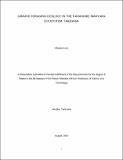Giraffe foraging ecology in the Tarangire Manyara ecosystem, Tanzania
Abstract
Management of rangelands requires knowledge of forage species that are preferred or avoided by
wildlife and livestock. The recent and rapid transformation of habitat by humans has led to
increased concerns about the proper management of rangelands. In East African savanna
ecosystems, the expansion of woody vegetation into previously open grasslands has led some
rangeland managers to advocate for the active removal of native bushes to maintain grazing
lawns in African savanna ecosystems. However, little is known about how browsing herbivores
might benefit from the ingrowth of woody vegetation. Diet selection by the Masai giraffe
(Giraffa camelopardalis tippelskirchi) was quantified in the Tarangire Manyara Ecosystem of
Tanzania. Instantaneous scan sampling was used to quantify foraged woody plant species and
compare those data with proportions of available woody plant species at two different spatial
scales during a wet and dry season and between areas of different protection statuses. Study
results showed that giraffes demonstrated strong selection towards some woody plant species
while avoiding others, both at the local and the landscape scale. Giraffes preferentially used more
forage species in less protected areas (8 forage species) than in a fully protected area (only 1
species). At both spatial scales, giraffes significantly preferred the shrub Dichrostachys cinerea,
a species that livestock managers have classified as encroacher species needing removal. This
preference was visible in the wet and dry seasons. The results of this study suggest that browsing
wildlife species such as giraffes may be adversely affected by the removal of D. cinerea from
rangelands and that managing for grazing livestock only could negatively impact browsing
wildlife on mixed-use lands.

